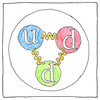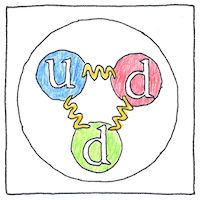James Chadwick
physics

|
Neutron
Although physicists thought the nuclei of atoms were conglomerates of protons and electrons, Ettore Majorana and Ernest Rutherford proposed the nucleus contains a new type of particle with no electric charge. James Chadwick found that radiating beryllium with alpha-particles caused another type of particle to radiate and knock protons from other elements. Heavier than a proton plus an electron, and having no electric charge, a neutron binds with a proton in an atomic nucleus by the nuclear force. Outside of a nucleus, neutrons are unstable, decay with a half-life of under fifteen minutes, and can mediate nuclear chain reactions.
Nuclear fission
When they absorb neutrons, uranium-235 and plutonium-239 split apart and release energy and additional free neutrons. The nuclear energy that holds neutrons and protons together in the atomic nuclei is released by splitting atoms.
Analogy is not
The nuclear force binds nucleons over only a few nuclear distances and at closer ranges becomes repulsive. The nuclear family supports members living in the same household but is an obstacle to personal growth. A common vocabulary suggests we understand nuclear forces and families in terms of each other although the opacity of both subjects exceeds the perspicacity of our probes.



Neutrons and protons are composed of triplets of quarks that are bound by the strong force which is mediated by gluons. The nuclear force is a result of a rhythmic exchange of gluons and quarks.
See also in The book of science:
Readings in wikipedia: